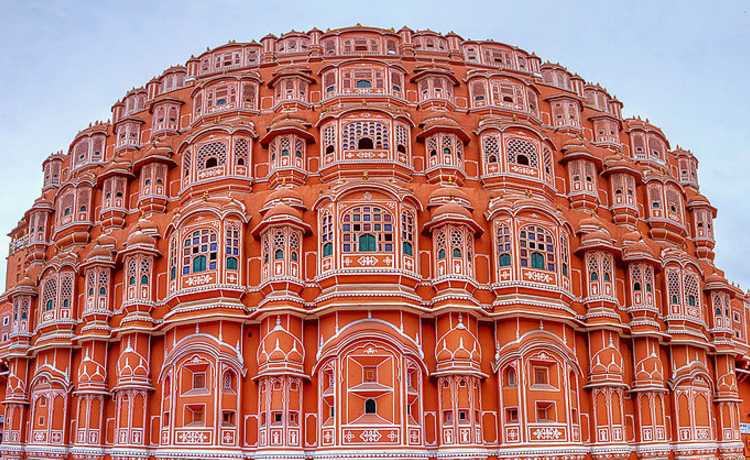Hawa Mahal, Jaipur Overview
The enormous structure of Hawa Mahal remains at the crossing point of the principal street in Jaipur, Badi Chaupad and was worked by Maharaja Sawai Pratap Singh in the year 1799. Hawa Mahal gets its name from its interesting construction, which is a lattice of little windows that permitted cool breeze to enter the royal residence and subsequently kept the castle happy with during the warm mid year months. The fundamental purpose for the castle's development was to permit the ladies of the imperial house to notice the celebrations on the roads while being concealed from an external perspective just like the custom of the land. It is found right on the edge of the City Palace Jaipur and stretches out right to the 'zenana'.
Hawa Mahal is a design made of red and pink sandstone and has a pyramidal construction which nearly looks like a crown. It has been decorated with 953 minuscule windows, otherwise called 'Jharokhas' and adorned with ravishing latticework. From the inside, the Hawa Mahal royal residence depends on five stories every one of which has an exceptionally brightened chamber. A beguiling wellspring invites you inside the fundamental royal residence, from whereon you can advance up to the various floors. The highest point of the castle offers a splendid perspective on the City Palace, Jantar Mantar and the consistently bustling Siredeori Bazar. There is a little exhibition hall too which holds a few rich relics and smaller than expected works of art.
The design was inherent 1799 by the Maharaja Sawai Pratap Singh, grandson of Maharaja Sawai Jai Singh, the organizer behind the city of Jaipur, India. He was so enlivened by the extraordinary construction of Khetri Mahal that he fabricated this fabulous and verifiable royal residence.
It was planned by Lal Chand Ustad. Its five-story outside is likened to a honeycomb with its 953 little windows called Jharokhas improved with perplexing latticework. The first aim of the grid configuration was to permit imperial women to notice daily existence and celebrations celebrated in the road beneath without being seen, since they needed to submit to the severe standards of "purdah", which prohibited them to show up in broad daylight without masks. This building highlight likewise permitted cool air from the Venturi impact to go through, consequently making the entire region more wonderful during the high temperatures in summer. Many individuals see the Hawa Mahal from the road view and think it is the front of the royal residence, however it is the back.
In 2006, remodel deals with the Mahal were embraced, following a hole of 50 years, to give a facelift to the landmark at an expected expense of Rs 4.568 million. The corporate area assisted protect the authentic landmarks of Jaipur and the Unit Trust of India has embraced Hawa Mahal to keep up with it. The royal residence is a lengthy piece of a colossal complex. The stone-cut screens, little casements, and curved rooftops are a portion of the elements of this famous place of interest. The landmark additionally has carefully displayed hanging moldings.
History of Hawa Mahal
Hawa Mahal was worked in 1799 by Maharaja Sawai Pratap Singh as a continuation of the illustrious City Palace and was planned by Lal Chand Ustad as Krishna's crown. Back then, the Rajputs used to follow the Purdah framework and the imperial ladies didn't show up before the general population. As they wished to follow the everyday occasions, the Hawa Mahal was worked with minuscule windows and screened galleries to give a feeling of opportunity among the ladies.
Design of Hawa Mahal
The explanation for the naming of Hawa Mahal is the design of the structure. It is a special five story Palace which seems to be like a honeycomb in light of the 953 little windows called jharokhas, and these windows permit the breeze to stream in and assists in keeping the castle with cooling. The Hawa Mahal is the tallest structure on the planet without establishment and due to the absence of one, the royal residence is shifted at a point of 87 degrees. Hawa Mahal remains at a rise of 50 feet over the ground and has little openings which comprise of smaller than expected windows and sandstone barbecues. The structure has no steps inside and one necessities to move up the inclines to arrive at the top.
To enter the Palace, you really want to traverse an Imperial entryway which is arranged towards the left of the structure. It gives way to an enormous patio which has three twofold storeyed structures towards the left, right and focus. The main three stories of the Hawa Mahal are just the width of one room, while the first and second floors have yards before them. The actual rooms are designed with vivid mosaics of glasses, fancy stonework and 'chhatris' which are a piece of the customary Rajasthani engineering.
Shopping At Hawa Mahal
Various little shops are arranged just external the royal residence premises, where you can purchase a wide assortment of present things as well as things of everyday use. This tremendous shopping region is otherwise called Badi Chaupal or Manek Chowk and is a main issue in the city. Articles like conventional dress, adornments, show-stoppers, jar, customary footwear or 'juttis', key chains and numerous such things are effectively accessible here. You can likewise purchase dress materials with Jaipuri print, sarees, adornments, handiworks, Rajasthani furniture and collectibles here. Various road merchants additionally sell heavenly tidbits like golgappas, bhelpuri, samosas and kachoris which are wonderfully delightful. There is a bistro inverse Hawa Mahal that gives an incredible perspective on this structural wonder.






0 Comments